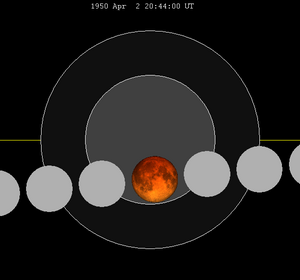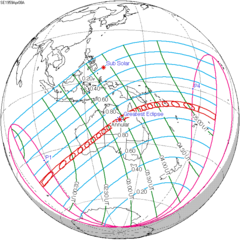|
April 1950 lunar eclipse
A total lunar eclipse occurred at the Moon’s descending node of orbit on Sunday, April 2, 1950,[1] with an umbral magnitude of 1.0329. A lunar eclipse occurs when the Moon moves into the Earth's shadow, causing the Moon to be darkened. A total lunar eclipse occurs when the Moon's near side entirely passes into the Earth's umbral shadow. Unlike a solar eclipse, which can only be viewed from a relatively small area of the world, a lunar eclipse may be viewed from anywhere on the night side of Earth. A total lunar eclipse can last up to nearly two hours, while a total solar eclipse lasts only a few minutes at any given place, because the Moon's shadow is smaller. Occurring only about 23 hours before perigee (on April 3, 1950, at 20:00 UTC), the Moon's apparent diameter was larger.[2] This lunar eclipse was the third of a tetrad, with four total lunar eclipses in series, the others being on April 13, 1949; October 7, 1949; and September 26, 1950. This was the first total lunar eclipse of Lunar Saros 131. VisibilityThe eclipse was completely visible over much of Africa, Europe, and the western half of Asia, seen rising over South America and setting over east and northeast Asia and Australia.[3]
Eclipse detailsShown below is a table displaying details about this particular solar eclipse. It describes various parameters pertaining to this eclipse.[4]
Eclipse seasonThis eclipse is part of an eclipse season, a period, roughly every six months, when eclipses occur. Only two (or occasionally three) eclipse seasons occur each year, and each season lasts about 35 days and repeats just short of six months (173 days) later; thus two full eclipse seasons always occur each year. Either two or three eclipses happen each eclipse season. In the sequence below, each eclipse is separated by a fortnight.
Related eclipsesEclipses in 1950
Metonic
Tzolkinex
Half-Saros
Tritos
Lunar Saros 131
Inex
Triad
Lunar eclipses of 1948–1951This eclipse is a member of a semester series. An eclipse in a semester series of lunar eclipses repeats approximately every 177 days and 4 hours (a semester) at alternating nodes of the Moon's orbit.[5] The penumbral lunar eclipses on February 21, 1951 and August 17, 1951 occur in the next lunar year eclipse set.
Saros 131Lunar Saros series 131, has 72 lunar eclipses. Solar Saros 138 interleaves with this lunar saros with an event occurring every 9 years 5 days alternating between each saros series. This eclipse series began in AD 1427 with a partial eclipse at the southern edge of the Earth's shadow when the Moon was close to its descending node. Each successive Saros cycle, the Moon's orbital path is shifted northward with respect to the Earth's shadow, with the first total eclipse occurring in 1950. For the following 252 years, total eclipses occur, with the central eclipse being predicted to occur in 2078. The first partial eclipse after this is predicted to occur in the year 2220, and the final partial eclipse of the series will occur in 2707. The total lifetime of the lunar Saros series 131 is 1280 years. Solar Saros 138 interleaves with this lunar saros with an event occurring every 9 years 5 days alternating between each saros series. Because of the ⅓ fraction of days in a Saros cycle, the visibility of each eclipse will differ for an observer at a given fixed locale. For the lunar Saros series 131, the first total eclipse of 1950 had its best visibility for viewers in Eastern Europe and the Middle East because mid-eclipse was at 20:44 UT. The following eclipse in the series occurred approximately 8 hours later in the day with mid-eclipse at 4:47 UT, and was best seen from North America and South America. The third total eclipse occurred approximately 8 hours later in the day than the second eclipse with mid-eclipse at 12:43 UT, and had its best visibility for viewers in the Western Pacific, East Asia, Australia and New Zealand. This cycle of visibility repeats from the initiation to termination of the series, with minor variations. Solar Saros 138 interleaves with this lunar saros with an event occurring every 9 years 5 days alternating between each saros series. Lunar Saros series 131, repeating every 18 years and 11 days, has a total of 72 lunar eclipse events including 57 umbral lunar eclipses (42 partial lunar eclipses and 15 total lunar eclipses). Solar Saros 138 interleaves with this lunar saros with an event occurring every 9 years 5 days alternating between each saros series.
The next occurrence was on April 13, 1968. The previous occurrence was March 22, 1932. Half-Saros cycleA lunar eclipse will be preceded and followed by solar eclipses by 9 years and 5.5 days (a half saros).[7] This lunar eclipse is related to two total solar eclipses of Solar Saros 138.
See alsoNotes
External links
|
|||||||||||||||||||||||||||||||||||||||||||||||||||||||||||||||||||||||||||||||||||||||||||||||||||||||||||||||||||||||||||||||||||||||||||||||||||||||||||||||||||||||||||||||||||||||||||||||||||||||||||














































